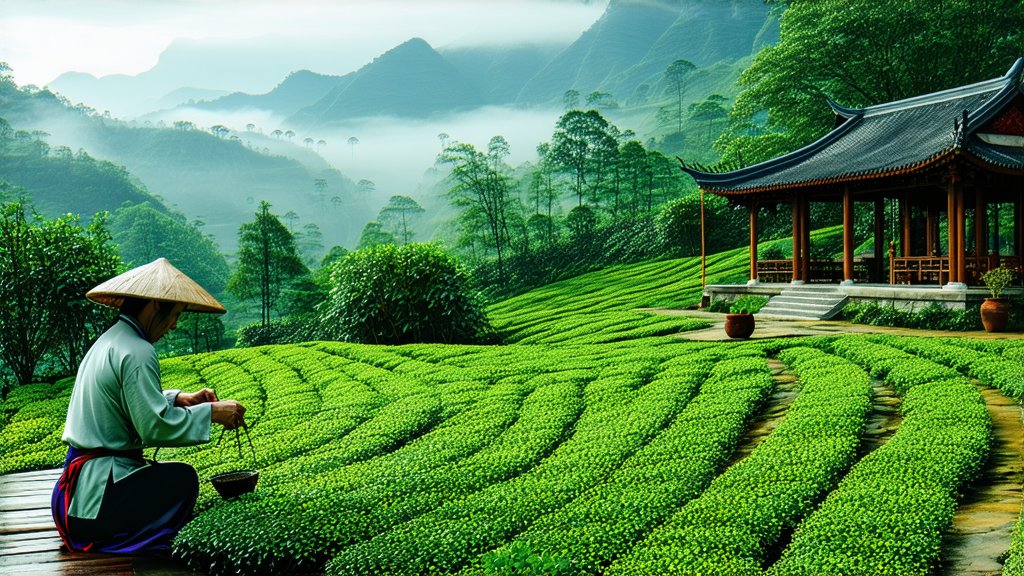
Nestled in the heart of China's Fujian province lies a treasure trove of tea history and heritage, where the art of tea cultivation has been perfected over centuries. Among the myriad varieties that grace this land, one stands out for its captivating aroma, complex flavor profile, and storied past – Tieguanyin, often referred to as the "Iron Goddess of Mercy." This exquisite Oolong tea not only embodies the essence of Chinese tea culture but also offers an unparalleled sensory experience that transcends borders.
A Glimpse into History
The origins of Tieguanyin date back to the early Qing Dynasty, around 1725 AD, during the reign of Emperor Yongzheng. Legend has it that the tea was discovered by Wei Rong, a poor scholar who found solace in nature after failing his imperial examinations. In his quest for tranquility, he stumbled upon a wild tea bush growing near a temple dedicated to Guanyin, the Goddess of Mercy. Impressed by its resilience amidst harsh conditions, he propagated the plant and named it "Tieguanyin," symbolizing the iron will of Guanyin.
Over time, Tieguanyin gained immense popularity within China and eventually crossed international waters, becoming a symbol of Chinese tea excellence worldwide. Its unique character and health benefits have made it a favorite among tea connoisseurs and enthusiasts alike.
Varieties and Characteristics
Tieguanyin is primarily grown in the Anxi region of Fujian, where specific microclimates and terroir contribute to its distinctive qualities. There are two main types: Anxi Tieguanyin and Gao Shan (High Mountain) Tieguanyin. While both share a common lineage, they exhibit subtle differences due to their altitude and growing conditions.
-
Anxi Tieguanyin: Grown at lower elevations, these teas tend to have a more robust body with pronounced floral and fruity notes, often accompanied by a sweet aftertaste.
-
Gao Shan Tieguanyin: Harvested from higher altitudes, these teas boast a lighter body with a more delicate fragrance, featuring hints of orchid and a lingering, smooth finish.
Regardless of the variety, true Tieguanyin is characterized by its tightly rolled, dark green leaves that unfurl into long, slender shapes when brewed. The liquor is typically a light golden hue, reflecting the tea's purity and craftsmanship.
The Art of Crafting Tieguanyin
The production of Tieguanyin is a meticulous process that demands precision, patience, and an intimate understanding of nature's rhythms. It involves several stages:
-
Plucking: Only the tender shoots and leaves are handpicked, usually during the spring and autumn harvests when the climate is ideal for optimal growth.
-
Withering: Freshly picked leaves are spread out under the sun or in shaded areas to reduce moisture content gradually, enhancing their aroma and flavor concentration.
-
Fixation: This step involves brief high-heat treatment to halt oxidation, preserving the Oolong characteristics while allowing some natural enzymatic activity to occur.
-
Rolling: Leaves are gently rolled to form tight pellets, which facilitates even drying and helps release the tea's essential oils during brewing.
-
Oxidation: Controlled exposure to oxygen allows partial oxidation, striking a balance between green and black tea properties, giving rise to Tieguanyin's signature complexity.
-
Roasting: Gentle roasting further refines the flavor profile, removing any residual moisture and imparting a warm, toasty note to the tea.
-
Sorting and Packaging: Finally, the tea is carefully graded based on quality before being packaged for sale, ensuring each batch meets the highest standards.
Savoring the Iron Goddess: A Guide to Tasting
To truly appreciate Tieguanyin, one must engage in the traditional Gongfu tea ceremony, a ritual that celebrates the harmony between man, nature, and tea. Here’s how you can embark on this sensorial journey:
-
Preparation: Use a Yixing clay teapot or a Gaiwan (a lidded bowl) for optimal heat retention and flavor extraction. Boil fresh water and let it cool slightly to around 90-95°C (195-205°F).
-
Warming: Rinse the teapot and cups with hot water to预热 them and enhance the tea's aroma.
-
Infusion: Place approximately 5 grams of Tieguanyin into the pot. Pour hot water over the leaves, covering them completely. Steep for about 30 seconds for the first infusion, then progressively increase steeping times for subsequent brews.
-
Aroma: Before sipping, take a moment to appreciate the fragrant steam rising from the cup. Inhale deeply to detect floral, fruity, or roasted notes.
-
Tasting: Sip slowly, allowing the tea to coat your palate. Notice the interplay of flavors—sweetness, bitterness, astringency, and umami—that dance harmoniously. Pay attention to the texture and mouthfeel, as well as the lingering aftertaste.
-
Multiple Infusions: Tieguanyin is known for its endurance; it can be steeped multiple times, each infusion revealing new dimensions of the tea's character. Adjust steeping times accordingly, starting from 30 seconds and doubling with each subsequent brew.
Conclusion
Tieguanyin is more than just a beverage; it is a testament to China's rich tea heritage and a gateway into understanding the philosophy of living in harmony with nature. From its mythical discovery to its intricate production process and nuanced tasting experience, Tieguanyin invites us to slow down, savor life's simple pleasures, and connect with a tradition that spans centuries. As you embark on your own exploration of this Iron Goddess, her enchanting aroma and profound flavors will undoubtedly leave an indelible mark on your tea journey.